图Lasso求逆协方差矩阵(Graphical Lasso for inverse covariance matrix)
作者:凯鲁嘎吉 - 博客园 http://www.cnblogs.com/kailugaji/
1. 图Lasso方法的基本理论
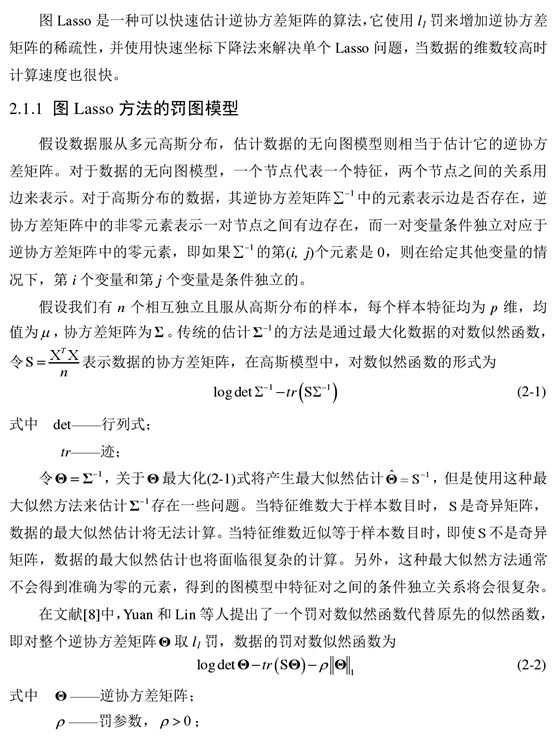

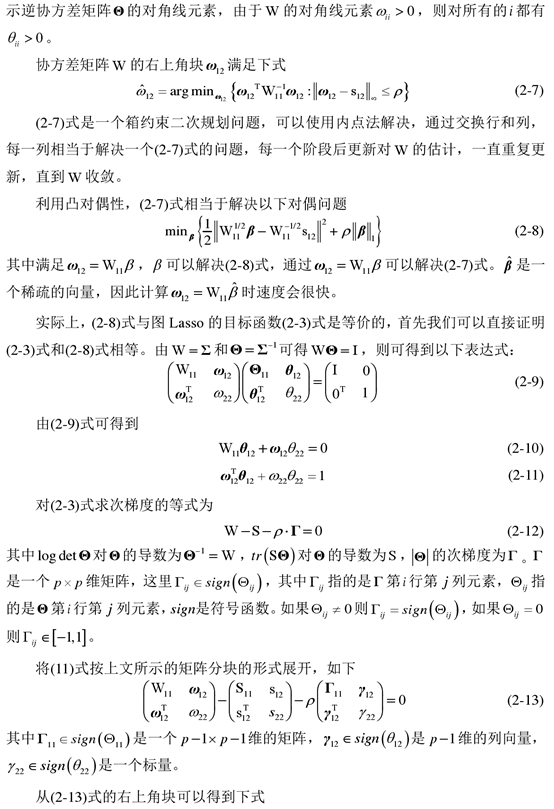
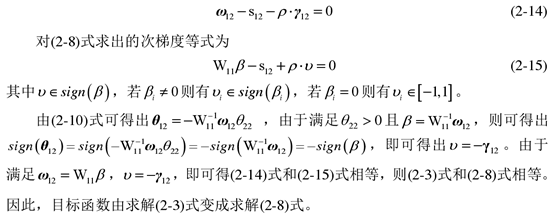
2. 坐标下降算法

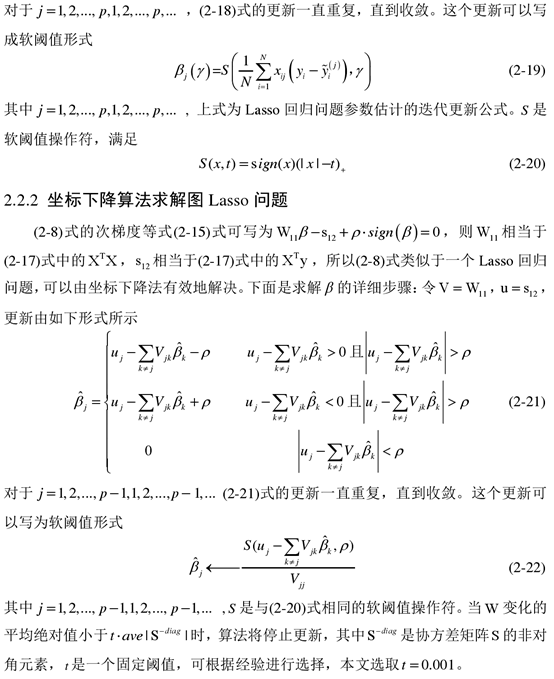
3. 图Lasso算法


4. MATLAB程序
数据见参考文献[2]
4.1 方法一
demo.m
1 2 3 4 5 6 7 8 9 10 11 12 13 14 15 | load SP500data = normlization(data);S = cov(data); %样本协方差[X, W] = glasso_1(double(S), 0.5);%X:sigma^(-1), W:sigma[~, idx] = sort(info(:,3));colormap grayimagesc(X(idx, idx) == 0)axis off%% Data Normalizationfunction data = normlization(data)data = bsxfun(@minus, data, mean(data));data = bsxfun(@rdivide, data, std(data));end |
glasso_1.m
1 2 3 4 5 6 7 8 9 10 11 12 13 14 15 16 17 18 19 20 21 22 23 24 25 26 27 28 29 30 31 32 33 34 35 36 | function [X, W] = glasso_1(S, lambda)%% Graphical Lasso - Friedman et. al, Biostatistics, 2008% Input:% S - 样本的协方差矩阵% lambda - 罚参数% Output:% X - 精度矩阵 sigma^(-1)% W - 协方差矩阵 sigma%%p = size(S,1); %数据维度W = S + lambda * eye(p); %W=S+λIbeta = zeros(p) - lambda * eye(p); %β=-λIeps = 1e-4;finished = false(p); %finished:p*p的逻辑0矩阵while true for j = 1 : p idx = 1 : p; idx(j) = []; beta(idx, j) = lasso(W(idx, idx), S(idx, j), lambda, beta(idx, j)); W(idx, j) = W(idx,idx) * beta(idx, j); %W=W*β W(j, idx) = W(idx, j); end index = (beta == 0); finished(index) = (abs(W(index) - S(index)) <= lambda); finished(~index) = (abs(W(~index) -S(~index) + lambda * sign(beta(~index))) < eps); if finished break; endendX = zeros(p);for j = 1 : p idx = 1 : p; idx(j) = []; X(j,j) = 1 / (W(j,j) - dot(W(idx,j), beta(idx,j))); X(idx, j) = -1 * X(j, j) * beta(idx,j);end% X = sparse(X);end |
lasso.m
1 2 3 4 5 6 7 8 9 10 11 12 13 14 15 16 17 18 19 20 21 22 23 24 25 26 | function w = lasso(A, b, lambda, w)% Lasso p = size(A,1);df = A * w - b;eps = 1e-4;finished = false(1, p);while true for j = 1 : p wtmp = w(j); w(j) = soft(wtmp - df(j) / A(j,j), lambda / A(j,j)); if w(j) ~= wtmp df = df + (w(j) - wtmp) * A(:, j); % update df end end index = (w == 0); finished(index) = (abs(df(index)) <= lambda); finished(~index) = (abs(df(~index) + lambda * sign(w(~index))) < eps); if finished break; endendend%% Soft thresholdingfunction x = soft(x, lambda)x = sign(x) * max(0, abs(x) - lambda);end |
结果
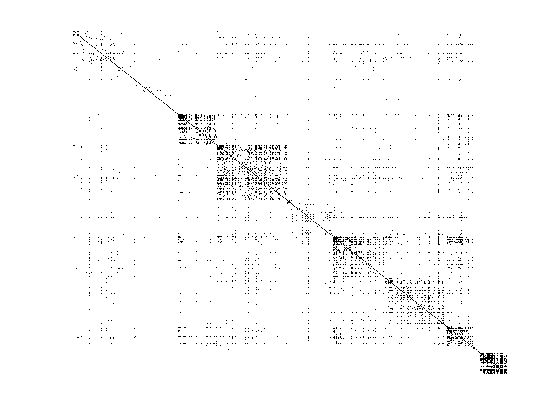
注意:罚参数lamda的设定对逆协方差的稀疏性的影响很大,可以用交叉验证方式得到。
4.2 方法二
graphicalLasso.m
1 2 3 4 5 6 7 8 9 10 11 12 13 14 15 16 17 18 19 20 21 22 23 24 25 26 27 28 29 30 31 32 33 34 35 36 37 38 39 40 41 42 43 44 45 46 47 48 49 50 51 52 53 54 55 56 57 58 59 60 61 62 63 64 65 66 67 68 69 70 71 72 73 74 75 76 77 78 79 80 81 82 83 84 85 86 87 88 89 90 91 92 93 94 95 96 97 | function [Theta, W] = graphicalLasso(S, rho, maxIt, tol)% http://www.ece.ubc.ca/~xiaohuic/code/glasso/glasso.htm% Solve the graphical Lasso% minimize_{Theta > 0} tr(S*Theta) - logdet(Theta) + rho * ||Theta||_1% Ref: Friedman et al. (2007) Sparse inverse covariance estimation with the% graphical lasso. Biostatistics.% Note: This function needs to call an algorithm that solves the Lasso% problem. Here, we choose to use to the function *lassoShooting* (shooting% algorithm) for this purpose. However, any Lasso algorithm in the% penelized form will work.%% Input:% S -- sample covariance matrix% rho -- regularization parameter% maxIt -- maximum number of iterations% tol -- convergence tolerance level%% Output:% Theta -- inverse covariance matrix estimate% W -- regularized covariance matrix estimate, W = Theta^-1p = size(S,1);if nargin < 4, tol = 1e-6; endif nargin < 3, maxIt = 1e2; end% InitializationW = S + rho * eye(p); % diagonal of W remains unchangedW_old = W;i = 0;% Graphical Lasso loopwhile i < maxIt, i = i+1; for j = p:-1:1, jminus = setdiff(1:p,j); [V D] = eig(W(jminus,jminus)); d = diag(D); X = V * diag(sqrt(d)) * V'; % W_11^(1/2) Y = V * diag(1./sqrt(d)) * V' * S(jminus,j); % W_11^(-1/2) * s_12 b = lassoShooting(X, Y, rho, maxIt, tol); W(jminus,j) = W(jminus,jminus) * b; W(j,jminus) = W(jminus,j)'; end % Stop criterion if norm(W-W_old,1) < tol, break; end W_old = W;endif i == maxIt, fprintf('%s\n', 'Maximum number of iteration reached, glasso may not converge.');endTheta = W^-1;% Shooting algorithm for Lasso (unstandardized version)function b = lassoShooting(X, Y, lambda, maxIt, tol),if nargin < 4, tol = 1e-6; endif nargin < 3, maxIt = 1e2; end% Initialization[n,p] = size(X);if p > n, b = zeros(p,1); % From the null model, if p > nelse b = X \ Y; % From the OLS estimate, if p <= nendb_old = b;i = 0;% Precompute X'X and X'YXTX = X'*X;XTY = X'*Y;% Shooting loopwhile i < maxIt, i = i+1; for j = 1:p, jminus = setdiff(1:p,j); S0 = XTX(j,jminus)*b(jminus) - XTY(j); % S0 = X(:,j)'*(X(:,jminus)*b(jminus)-Y) if S0 > lambda, b(j) = (lambda-S0) / norm(X(:,j),2)^2; elseif S0 < -lambda, b(j) = -(lambda+S0) / norm(X(:,j),2)^2; else b(j) = 0; end end delta = norm(b-b_old,1); % Norm change during successive iterations if delta < tol, break; end b_old = b;endif i == maxIt, fprintf('%s\n', 'Maximum number of iteration reached, shooting may not converge.');end |
结果
1 2 3 4 5 6 7 8 9 10 11 12 13 14 15 16 17 18 19 20 21 | >> A=[5.9436 0.0676 0.5844 -0.0143 0.0676 0.5347 -0.0797 -0.0115 0.5844 -0.0797 6.3648 -0.1302 -0.0143 -0.0115 -0.1302 0.2389];>> [Theta, W] = graphicalLasso(A, 1e-4)Theta = 0.1701 -0.0238 -0.0159 0.0003 -0.0238 1.8792 0.0278 0.1034 -0.0159 0.0278 0.1607 0.0879 0.0003 0.1034 0.0879 4.2369W = 5.9437 0.0675 0.5843 -0.0142 0.0675 0.5348 -0.0796 -0.0114 0.5843 -0.0796 6.3649 -0.1301 -0.0142 -0.0114 -0.1301 0.2390 |
5. 补充:近端梯度下降(Proximal Gradient Descent, PGD)求解Lasso问题


6. 参考文献
[1] 林祝莹. 图Lasso及相关方法的研究与应用[D].燕山大学,2016.
[2] Graphical Lasso for sparse inverse covariance selection
[3] 周志华. 机器学习[M]. 清华大学出版社, 2016.
[4] Graphical lasso in R and Matlab
[5] Graphical Lasso


【推荐】还在用 ECharts 开发大屏?试试这款永久免费的开源 BI 工具!
【推荐】国内首个AI IDE,深度理解中文开发场景,立即下载体验Trae
【推荐】编程新体验,更懂你的AI,立即体验豆包MarsCode编程助手
【推荐】轻量又高性能的 SSH 工具 IShell:AI 加持,快人一步